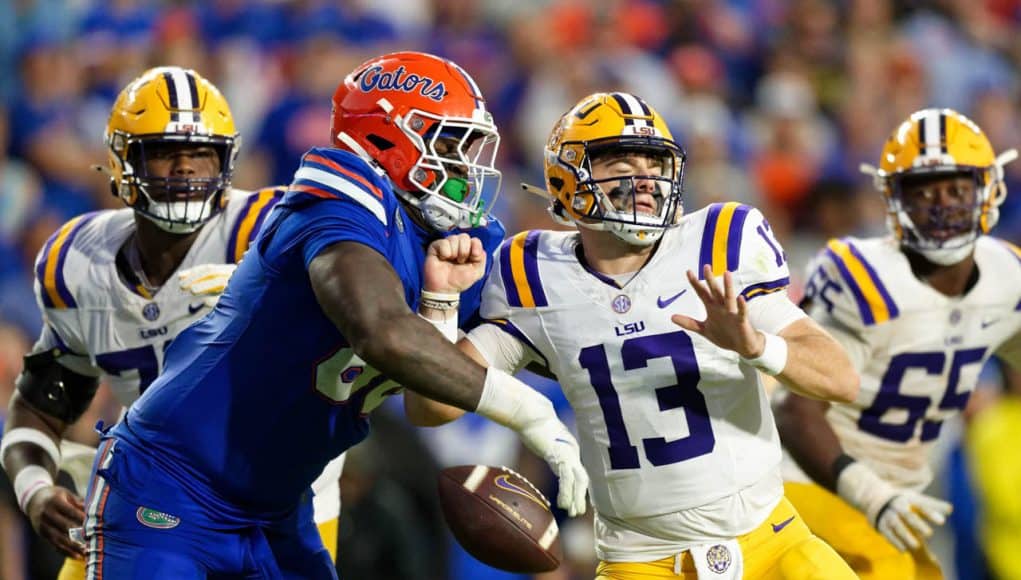Unfinished in the Swamp: Why Caleb Banks Passed on the Draft, Bet on Billy Napier, and Came Back to Turn Florida’s 2025 Defense Mean
Caleb Banks could’ve left. Not in theory—in reality. Long-framed defensive linemen with SEC reps don’t wait long to get poked by the NFL advisory ecosystem, and Banks had already checked some of the boxes scouts love: length that clogs vision lanes, a wingspan built to forklift guards, enough movement skill to slide across fronts, and flashes on tape that made pro personnel departments scribble “what if?” in the margins. Add in a transfer-story arc, rotational growth, and the rising market for multi-gap bigs who can both eat double teams and disrupt passing windows, and a jump to Sundays—or at least a portal spin toward a presumed playoff contender—would’ve been easy to justify. Instead, Banks did something that speaks louder in today’s churn-happy college world than it might have a decade ago: he came back. He came back to Gainesville, to a Florida program perched on the 2025 cliff between progress and pressure, to a defensive room that needs identity as badly as it needs depth, and to a head coach in Billy Napier whose culture-first blueprint is nearing its hard proof date. Ask why, and Banks doesn’t give you one answer; he gives you a stack. Development. Draft grade honesty. Locker-room responsibility. NIL stability without ego. The chance to anchor—not cameo—on a line that could decide whether Florida climbs or slides in the SEC’s next shuffle.
Banks’ decision started with film, not feelings. NFL evaluation calls came back with a theme scouts rarely bother softening: the upside’s obvious, but the body of dominant, full-snap tape isn’t big enough yet. Teams love projection until they have to put a pick on the line; raw traits without a full-year track record of leverage truth—hat placement, pad consistency, block destruction when gassed—get bumped rounds. Banks had explosive clips that turned heads, but he also had stretches where pad level drifted or pursuit angles flattened late. One more college year used right could turn “interesting Day 3 upside” into “Day 2 anchor who fits multiple fronts.” He listened. Plenty of players don’t. That alone tells you something about his wiring.
Then came the internal review with Florida’s staff. Napier and the defensive line coaches pulled cutups—good, bad, in-between—and mapped a development plan in surgical detail. Strength splits from the fourth quarter vs the first. Win rates when shaded inside compared to head-up alignments. How often he reset hands after losing first contact. Whether his get-off varied by down-and-distance. Banks wanted that granularity. “Don’t sell me dreams,” he told people close to the program this winter. “Show me where I need work and how we’re fixing it.” The coaches did. They didn’t promise gaudy sack totals; they promised more reps in attack packages, a heavier rotation of movement calls to unlock his length, and a winter of functional strength that would let him hold anchor without sacrificing twitch. When a player and staff speak the same improvement language, returning makes sense.
NIL is the accelerant—and complication—beneath every high-profile stay-or-go decision now, but Banks’ calculus landed in a rare sweet spot. Florida’s collective structure has matured to the point where proven contributors can receive meaningful retention packages that reward production without detonating locker-room balance. Did the money match an NFL rookie deal? No. Did it validate his value, cover family considerations, and let him chase a higher draft range without financial anxiety? By all accounts, yes. The broader takeaway matters more: schools that want to keep developmental linemen must pair transparent draft feedback with credible retention dollars. Florida did both. Banks noticed. So did his teammates.
But if money and grades were the only pieces, this would be a transactional footnote. What’s driving the emotional current is the state of Florida’s defense and what Banks thinks it can become with one more year of buy-in. The Gators have talent scattered across levels—young edge juice, length at linebacker, flashes in the secondary—but too often the engine sputtered because the interior couldn’t dictate. Elite SEC defenses start where the ball is snapped; everything downstream—run fits, blitz disguise, coverage aggression—rests on whether the A and B gaps hold. Banks is built to change that math. His first step forces offensive lines to declare; his arm length lets him two-gap in a pinch; his lateral range narrows cutback lanes that ate Florida alive in high-tempo games. More importantly, he’s no longer learning the system on the fly. One more camp, one more install cycle, and a leadership voice that says “gap first, glory second” could flip Florida’s entire defensive temperament.
Leadership is the piece Banks never talked much about when he arrived but now wears by default. Veterans left. Younger linemen look at who wins reps. Banks wins a lot. Florida’s staff leaned into that, pushing him to take film-point roles in position meetings and front the accountability conversations when effort dipped. Returning means leaning all the way in. Teammates say he’s louder now—not in sound-bite hype, but in call-outs you hear on the practice field when alignments slip or pad height climbs. Defensive culture is built on repetition and shared anger; Banks is learning how to light both without burning teammates. If that sticks, Florida’s inconsistency—those maddening drives where two great snaps combust into a 34-yard bust—can tighten.
There’s also unfinished business against helmets Banks sees every day in the facility weight room wall art: Georgia, Tennessee, LSU. SEC ball is cyclical but not sentimental; if you want to shift how people talk about you, you do it in rivalry games. Banks doesn’t wear blame for past losses, but he wears the residue. Ask him off-camera and he’ll tell you bluntly Florida has given away too many fourth quarters up front. “If we’re who we say we are,” he’s said in team settings, “they don’t run on us when it matters.” That mindset, fused to a senior year, is combustible in the best way if it spreads.
Technically, this offseason has been about compression. Banks spent winter and spring tearing apart his stance mechanics and strike path. At his length, pad discipline is everything; too tall and SEC guards forklift you into the second level. He worked short-step explosiveness, repped independent hand swipes to clear down blocks, and hammered cross-face redirection on outside zone because Florida saw far too many backs plant and cut behind over-penetration last fall. He’s lighter in the torso but thicker in the posterior chain—functional mass that improves reset power after initial contact. Coaches say his conditioning splits improved; finishing effort through the whistle has always popped in flashes, but the staff wants it constant. If he holds his burst into the 50th snap the way he does in his 5th, production climbs even without schematic freebies.
Scheme tweaks will help. Florida is expected to mix more movement up front—tackle-end stunts, interior slants, simulated pressure that turns Banks loose into gaps offensive linemen think are protected. That favors length players who can re-route mid-stride. It also lets the Gators vary front presentations pre-snap, muddying protection calls for tempo offenses and giving linebackers cleaner reads. Banks’ return gives the staff courage to call that stuff more often; you don’t build a coverage-with-confidence menu unless you trust the down linemen to hold water when pressure bluffs bail out.
Draft stock hovers over all of it. Scouts want to see dominance in defined roles. Can Banks stack three SEC games of 35+ snaps with graded wins against NFL-caliber guards? Can he show pass-rush counters beyond the long-arm? Will he post pressures when isolated one-on-one on third down rather than just survive double teams on early downs? Those boxes remain partially checked. Another year gives him live auditions. The difference between going in the middle rounds and hearing your name early on Day 2 is often half a dozen snaps in which you beat pro bodies clean. Banks knows. That’s why he came back to face the best lines in the country instead of shining against lower-volume chaos elsewhere. Iron sharpens draft grade.
Billy Napier needed this win. Retention of high-ceiling veterans signals program health in an era where the portal makes annual roster shock normal. Keeping Banks says Florida’s internal alignment—coaches, collectives, player development—can compete with the gravitational pull of both the NFL and poaching rivals. It gives Napier a flagship defender around whom to sell recruits an identity: come here, get built, get paid, chase championships, and leave better than you arrived. If Florida’s 2025 defense takes a step, Banks becomes the poster. If it doesn’t, at least the staff can’t say they lacked building blocks. Responsibility cuts both ways.
Stand in The Swamp on a September night and watch center exchanges in the sweat-haze; you’ll see why defensive linemen define SEC seasons. Violence at the snap collapses game plans. Florida hasn’t owned enough of that in recent years. Caleb Banks returned to change it. He returned because scouts told him growth remained, because coaches showed him how, because teammates asked him to lead, because NIL let him bet on himself without gambling stability, because beating Georgia matters, because legacy matters, because one more year of work might turn flashes into film that gets him paid for a decade. That’s not a sentimental story—it’s a competitive one.
If it works, the 2025 Gators could look back and say the season their defense matured began not with a signing class but with a decision: a long, lean lineman stared at the league, stared at the portal, and chose sweat in Gainesville instead. In an SEC built on fast money and faster exits, that choice feels almost radical. Florida will spend the fall trying to make it prophetic.



